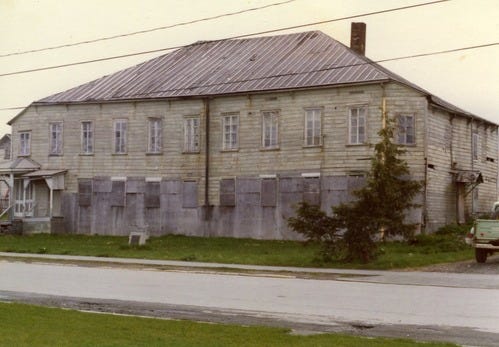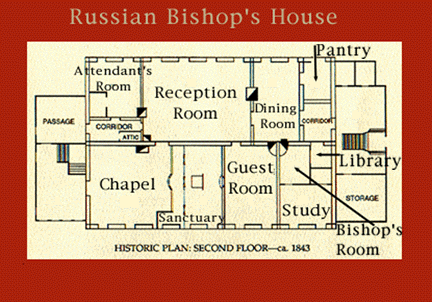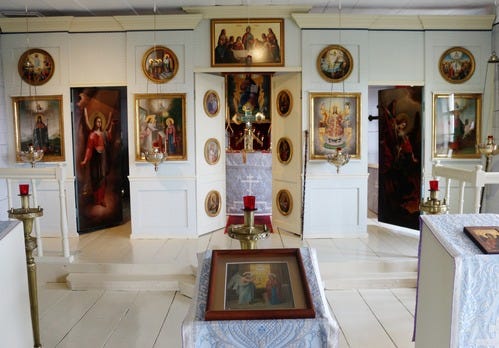Echoes of the Past: The Russian Bishop's House and Sitka's Legacy
Preserving History and Culture at the Crossroads of Empires
My husband spent part of his career as the Chief Ranger at Sitka National Historical Park. Bringing the Russian Bishop’s House back to life was something he counts as one of his significant life accomplishments. This blog post is dedicated to him.
Sitka's Rich Heritage and the Russian Bishop's House
Sitka, Alaska, unfolds on the western shore of Baranof Island, surrounded by the dramatic beauty of the North Pacific and the verdant expanse of the Tongass National Forest. The town blends Tlingit, Russian, and American influences and reflects the layers of history that have shaped this region. Amid this scenic and cultural tapestry stands the Russian Bishop's House. This venerable structure, one of the few surviving examples of Russian colonial architecture in North America, is a testament to a bygone era when Russia's empire extended into North America.
The Russian presence in Alaska began in the mid-18th century with the arrival of explorers and fur traders. Driven by the lucrative fur trade, particularly the demand for sea otter pelts, the Russians established settlements and trading posts along the rim of the North Pacific Ocean. These early ventures began the Russian Empire's colonial activities in Alaska, setting the stage for a profound interaction with the indigenous peoples and the natural landscape.
Sitka, originally known as New Archangel, emerged as the capital of Russian America in 1808, replacing the earlier settlement of Kodiak. Its strategic location, protected harbors, and access to resources made it the administrative and commercial center of Russian activities in Alaska. Sitka became a melting pot of cultures, where Russians, Aleuts, the indigenous Tlingit people, and Euro-American merchant sailors interacted, traded, and sometimes conflicted.
The Bishop's House: A Symbol of Faith and Education
The Russian Bishop's House, built in 1842, symbolized the Russian Orthodox Church's role in Alaska. Constructed by the Russian American Company, the House served as the residence of the Archbishop of Alaska, Kamchatka, and the Kurile Islands, Bishop Innocent (Ivan Veniaminov), who oversaw the spread of Orthodox Christianity among the indigenous populations and the Russian settlers. It also housed a school, a chapel, and a seminary. The establishment of schools within its precincts focused on educating the indigenous Tlingit children, teaching them the tenets of Christianity, and imparting knowledge in arts, crafts, and the Russian language. This educational endeavor was part of a broader strategy to integrate the Tlingit people into Russian colonial society and the local economy.
The transfer of Alaska to the United States in 1867 marked a turning point for the Russian Bishop's House. While many Russian-era buildings were repurposed or fell into disrepair, the Bishop's House continued to serve religious and community functions. The Orthodox Church maintained a presence in Alaska, using the House for religious services, education, and as a residence for clergy.
In the years following the Alaska Purchase, the House witnessed various changes in use that reflected the shifting needs of the community and the church. While it continued to serve as a symbol of the Russian Orthodox heritage in Alaska, its role evolved. Parts of the building were used for different purposes, including as a school and community center. Despite these changes, the significance of the House as a historical and cultural landmark remained undisputed.
Preservation and Restoration Efforts
As the 19th century progressed to the 20th, the Russian Bishop's House faced challenges related to its preservation. Without formal protection or resources dedicated to its maintenance, the structure began to show signs of wear and neglect. The harsh Alaskan weather and the building's age threatened its structural integrity and the preservation of its historical features.
The need to preserve the Russian Bishop's House became apparent. Initially, preservation efforts were sporadic and primarily driven by the local community and the Orthodox Church, which recognized the building's historical and religious significance. However, these early efforts lacked the coordination and resources necessary for comprehensive restoration.
A significant turning point in the preservation of the Russian Bishop's House came with its designation as a National Historic Landmark in 1962. This recognition by the National Park Service underscored the building's importance in American history and brought national attention to its preservation needs. The designation was crucial in securing the support and funding required for a more structured and effective preservation strategy. The addition of the Russian Bishop’s House to Sitka National Historical Park went a long way to making the House’s preservation possible.
Preserving the Russian Bishop's House was a collaborative effort involving various stakeholders, including the National Park Service, the Orthodox Church, historical societies, and the local community. Securing funding for restoration projects was a critical aspect of the preservation efforts. Federal and state grants, Congressional appropriations, and private donations supported the extensive work needed to restore and maintain the building.
Architectural Significance and Legacy
The restoration of the Russian Bishop's House involved meticulous work to stabilize the structure, repair deteriorating elements, and restore the building to its historical appearance. Key projects included:
Structural Stabilization: Ensuring the building's structural integrity was a priority. This involved reinforcing the foundation, repairing or replacing support beams, replacing the roof, and addressing issues caused by water damage and rot.
Exterior Restoration: The House's exterior, including its wood siding, windows, and roof, was carefully restored using materials and techniques consistent with the original construction to preserve its historical authenticity.
Interior Conservation: The interior of the House, including its historic chapel, living quarters, and educational spaces, was painstakingly restored. Efforts were made to conserve original artifacts, icons, and furnishings, and to replicate original finishes where necessary.
Accessibility and Safety Improvements: Modern updates to improve accessibility for visitors and ensure the building meets safety standards were implemented, all while maintaining the integrity of the historic design.
Through this careful preservation, the house emerged as a structure and a storyteller. The House was built by Finnish shipwrights employed in the New Archangel shipyard. They used ship construction techniques such as locking scarf joints to join logs together and raised thresholds as found on ships to prevent water (here, drafts) from flowing between rooms.
The architecture of the Russian Bishop's House is a distinctive example of Russian/Siberian colonial architecture, reflecting both the practical needs and the cultural influences of its era. It showcases the fusion of Russian architectural style with local Alaskan materials and conditions, embodying Sitka’s unique historical and environmental context.
Characterized by its simple yet functional design, the two-story building is made primarily of local spruce, a material chosen for its availability and durability in the harsh Alaskan climate. Its exterior walls are clad in wood siding, painted in colors that have varied over time but historically have included the traditional white with green or red trim, echoing the color schemes commonly found in Russian ecclesiastical and administrative buildings of the period. Based on original paint samples, the restored Russian Bishop’s House is ochre (yellow) with a red standing-seam iron roof. Russian American Company buildings were frequently white with green roofs. The building is topped with a striking, steep, gabled roof designed to shed snow efficiently, a necessary adaptation to the heavy snowfalls of Southeast Alaska.
The interior is divided into several key areas, each serving a specific function related to its original use as a residence for the bishop and a center for the Orthodox Church in the region. The ground floor historically housed service areas, including a kitchen, classroom, dormitory, and storage, while the upper floors contained the bishop’s living quarters, office, and chapel.
The chapel is perhaps the most significant interior space, adorned with original religious icons, artifacts, and furnishings that reflect the deep spiritual heritage of the Russian Orthodox Church. This space accommodated worship and religious ceremonies, serving as a spiritual hub for the Russian community and indigenous converts. It has been reconsecrated and is used by the Orthodox community on special occasions.
The house features several architectural details that are noteworthy. Windows are framed with trim and shutters, reflecting a functional need for insulation, light control, and aesthetic preferences of the time. Striking features are the false windows and doors on the right end of the building. These exist to preserve the symmetry of the building, to economize on the use of glass, and to preserve heat. The use of hand-crafted joinery and traditional woodworking techniques is evident in the construction of the house, showcasing the skill and craftsmanship of its builders.
Interior details include wood flooring and paneled doors. The building was heated using traditional Russian stoves – massive brick blocks with a sinuous flue system that heated the brick mass using small fires. The smoke curled through the block, heating the mass such that it stayed warm for hours. The kitchen stove had openings for cooking, and one of the cook’s privileges was to sleep on the stove shelf after the cooking was done. The use of local materials and adaptation to the local climate is evident throughout the house's design and construction, reflecting a blend of Russian architectural traditions with pragmatic considerations of life in Alaska.
Preserving History: The Legacy of the Russian Bishop's House in Sitka
One of only four Russian colonial buildings in the Western Hemisphere, the Russian Bishop's House, through its storied past and the concerted efforts of preservation, stands today not only as a monument to the rich tapestry of cultures that have shaped Sitka but also as a beacon of architectural heritage and historical insight. From its origins in the mid-18th century, amid the bustling trade and cultural exchanges of Russian America, to its pivotal role under the auspices of figures like Bishop Innocent, the House has been a witness to the ebb and flow of history on the shores of Baranof Island. Its continuous use, adapted over the years to meet the evolving needs of the community and the church, underscores the enduring significance of this landmark, not just as a relic of the past but as a living part of Sitka's cultural and spiritual landscape.
The journey from sporadic local preservation efforts to comprehensive restoration projects supported by national recognition and collaborative stakeholder engagement reflects a broader recognition of the importance of safeguarding our cultural heritage. The designation of the Russian Bishop's House as a National Historic Landmark was a watershed moment, catalyzing a structured approach to its preservation and ensuring that future generations would have the opportunity to engage with this tangible link to the past.
The meticulous restoration work, from structural stabilization to interior conservation, has breathed new life into the house, allowing it to tell its story more fully and vividly. The preservation of its distinctive Russian colonial architecture, a fusion of Russian design and Alaskan practicality, offers a window into the ingenuity and adaptability of those who built and maintained it through the years. This effort has preserved the building's physical integrity and maintained its soul, encapsulating the spiritual and cultural narratives integral to understanding Alaska's complex history.
In conclusion, the Russian Bishop's House is a testament to the layers of history that have shaped Sitka and Alaska, a monument to the resilience of cultural heritage against the ravages of time and change. It reminds us of the importance of preservation, not merely for the sake of maintaining old buildings but for the stories they hold and the connections they foster between the past and the present. Through its architecture and the ongoing efforts to preserve it, the Russian Bishop's House continues to serve as a vibrant center for education, reflection, and appreciation of the diverse threads that weave together to form the fabric of Alaskan history.









